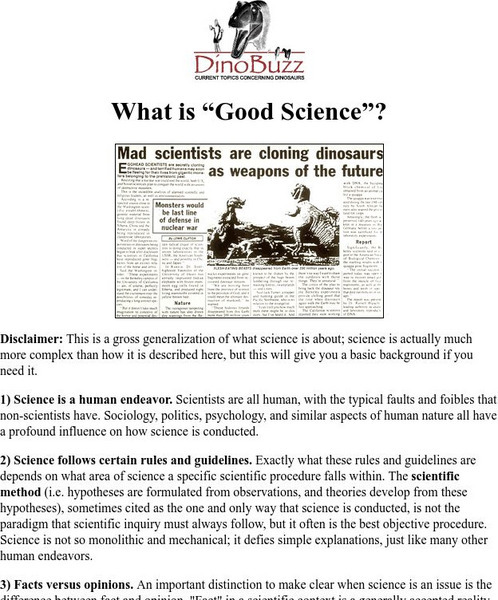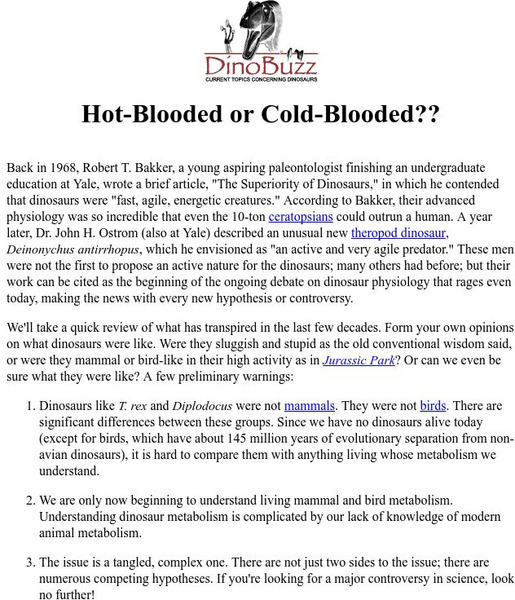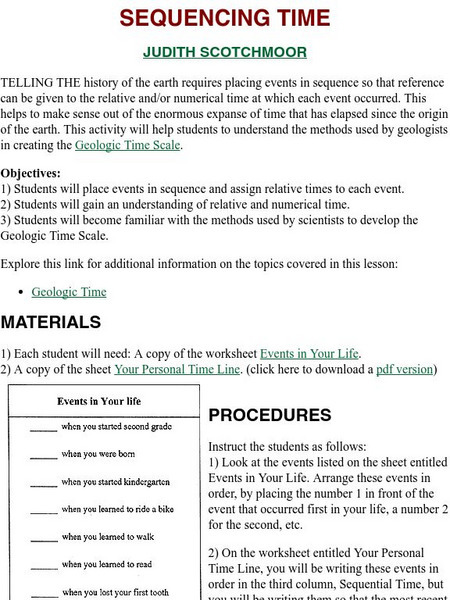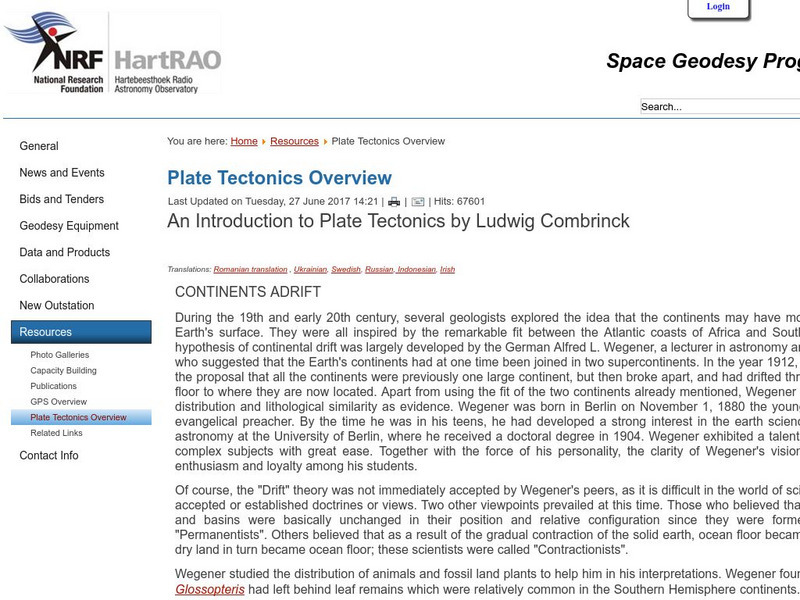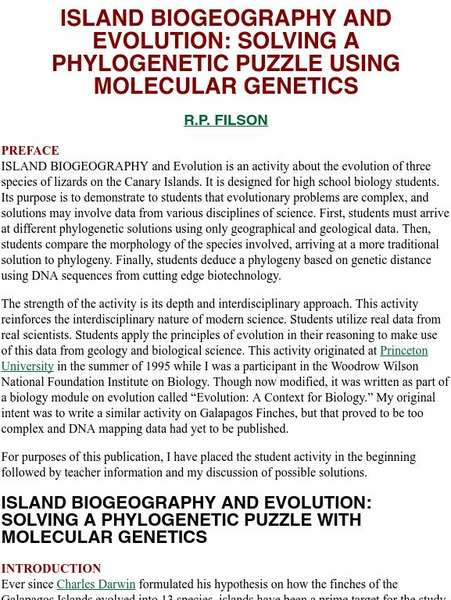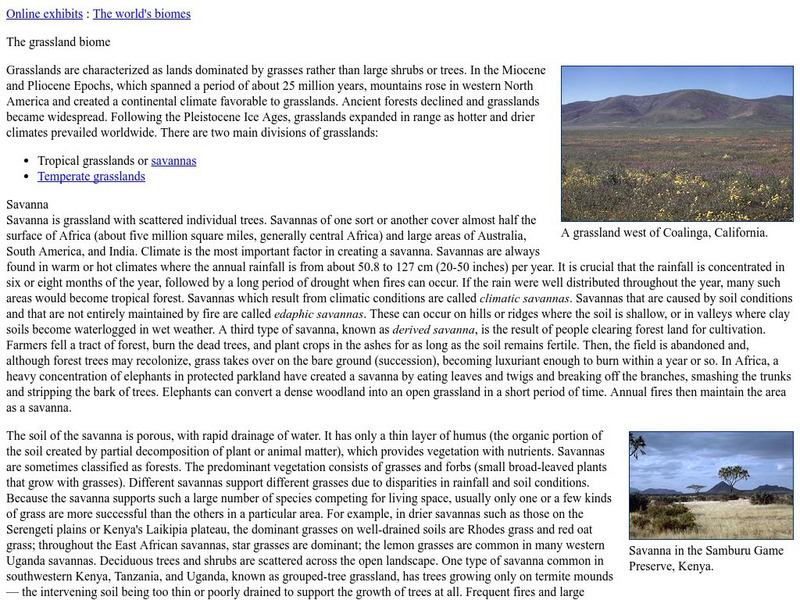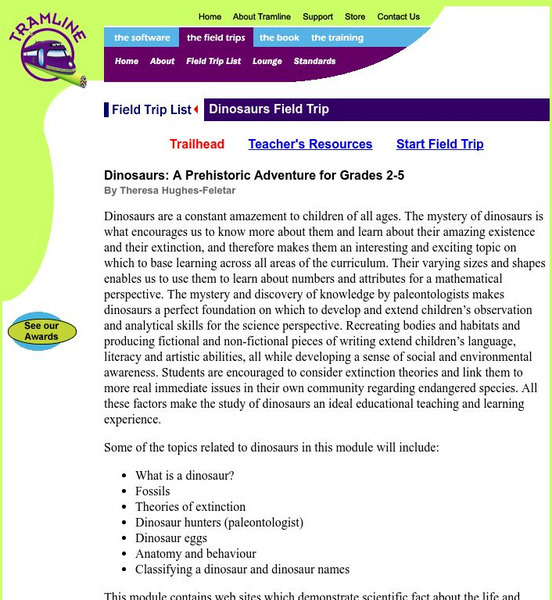University of California
Ucmp: What Is "Good Science"?
A very good explanation of the scientific process and the differences between science and non-science. This is a concise and clearly written description.
University of California
Ucmp: Hot Blooded or Cold Blooded?
An easy-to-understand explanation of what it means to either hot- or cold-blooded.
University of California
Ucmp: Plantae
At this resource learners can take a look at the plant kingdom with a detailed examination of fossil records, life history and ecology, systematics, and morphology.
University of California
Ucmp: Life Has a History
University of California site showcases how different types of organisms exist on the Earth and the history of life.
University of California
Ucmp: Sequencing Time
Lesson plan in which students place events in sequence, comparing their life to the history of the Earth.
University of California
Ucmp: Introduction to the Archaea
Berkley offers an introduction to archaebacteria--ancient bacteria--including the history of the topic, scientific findings, and where to find archaeans. Includes images and links.
University of California
Ucmp: The Cretaceous Period
This site from the UCMP Berkeley provides information about the Cretaceous Period, the last portion of the age of the dinosaurs and the continued break up of the continent of Pangaea.
University of Nebraska
Univ. Of Nebraska Museum: Preserving Vertebrate Fossils
This resource details the process by which vertebrate fossils should be excavated and preserved in order to conserve them for as long as possible. It also includes information about the role of amateur fossil collectors and museums.
University of California
Ucmp: The World's Biomes
This is an introduction to the major biomes on Earth. This page groups biomes into five major types: aquatic, deserts, forests, grasslands, and tundra. Information on climate, animal/plant life, and much more is given for each of type...
Other
Hartao: An Introduction to Plate Tectonics
Introduces South African Alexander Toit as naming Gondwanaland and Laurasia.
University of California
Ucmp: What Did T. Rex Taste Like?
The title could be slightly misleading for this site. It is actually a teaching and learning module on the science of cladistics. As they go through the module, students will increase their understanding of, and appreciation for, the...
University of California
Ucmp: Island Biogeography and Evolution
This is a lesson designed by a biology teacher. In it, students use maps and evidence of island age, molecular genetics, morphology, and distance apart to determine how the islands came to be occupied by different species of lizards. It...
University of California
Ucmp: Grassland Biome
Learn all about the grassland biome including where located in the world, climate, flora and fauna, and soil. Good research site for middle years students.
University of California
Ucmp: The Desert Biome
Learn about the four types of deserts: hot and dry, semiarid, coastal, and cold with this key facts and information. Includes links to other biomes: aquatic, forest, grasslands, and tundra.
University of California
Ucmp: Forest Biome
Learn all about the forest biome including where located in the world, different kinds, climate, flora and fauna, and soil. Good research site for middle years students.
American Museum of Natural History
American Museum of Natural History: O Logy: Face to Fossil: Protoceratops
Questions and answers about Protoceratops andrewsi, presented as an "interview" with a museum's fossil. Learn about the dinosaur, the age of the fossil, and how the museum had it transported.
University of Nebraska
Ashfall Fossil Beds State Historic Park
The Ashfall Fossil Beds are located in Nebraska. Much of the research done there is conducted by scientists from the University of Nebraska and the Nebraska State Museum. The history, geology and paleontology of the site are described....
Other
Prehistoric Planet: Interview With Dr. Mary R. Dawson
Dr. Mary R. Dawson works as a curator in the vertebrate paleontology department at the Carnegie Museum of Natural History. Here she talks about her career and research she has done.
Other
Tramline: Dinosaurs: A Prehistoric Adventure for Grades 2 5
Travel across the Internet to learn about dinosaurs in this virtual field trip. The trip is designed for Grades Two to Five. Topics include dinosaur fossils, extinction, paleontology, anatomy, behavior, etc.
Other
Museum of the Rockies: Jack Horner
Jack Horner, a well-known figure in the study of dinosaurs, is profiled here. He is responsible for many 'firsts' in paleontology, such as his discovery of the first dinosaur eggs.
Other
The Mammoth Site of Hot Springs, South Dakota
General site describes history and origin of the Mammoth. Includes links to paleontology, geology and archeology sites that are related to the study of the Mammoth.
TED Talks
Ted: Ted Ed: The Ferocious Predatory Dinosaurs of Cretaceous Sahara
Nizar Ibrahim uses paleontological and geological data to reconstruct the 'River of Giants' in north Africa in surprising detail.
Talk Origins Archive
Talk Origins: Fossil Hominids: Richard Leakey
Biography of Richard Leakey that deals with his paleontological work and his efforts to preserve African wildlife.
PBS
Pbs Learning Media: Whales in the Making
This graphic from Evolution, traces the evolution of whales from land-dwelling mammals to the aquatic creatures we know today. A PDF is included that diagrams the evolutionary process that is believed to have taken place.
Other popular searches
- Paleontology Dinosaurs
- Paleontology Fossils
- Paleontology Hominid
- Paleontology Math
- Fossil Paleontology
- What Is Paleontology
- Paleontology Seas
- Paleontology and Dinosaurs
- Paleontology Vocab
- Marsh Paleontology
- Paleontology Unit
- Social Studies Paleontology
